Double Height DDR4: 32GB Modules from G.Skill and ZADAK Reviewed
by Ian Cutress & Gavin Bonshor on January 23, 2019 9:00 AM ESTDouble Height DDR4 Conclusion
In this review we have tested the new 32 GB DDR4 modules from both G.Skill and Zadak. These modules are 'double the height' of traditional DDR4 memory, as they essentially use two modules worth of DRAM chips to achieve the double capacity. The modules do this through adjusting the pins on the DDR4 interface as if one memory slot were responsible for two memory sticks. This change means that these modules need to be qualified for motherboards on a per-motherboard basis. To that extent, at the time of the review, these modules are only validated on three ASUS ROG motherboards. These are enthusiast grade motherboards, to go along with enthusiast grade memory.
The benefit of these 32 GB DDR4 modules means that a motherboard with only two memory slots can achieve 64 GB of memory by using 2x32 GB, rather than the current limit of 2x16 GB. The penalty for using the memory comes in the form of physical space on the motherboard - the G.Skill kit we tested is substantially taller than its regular counterpart, while the Zadak kit we tested is marginally taller. In both circumstances, the manufacturers recommend that liquid cooling is used on the processor on the motherboard, given the difficulty that air coolers can have with tall memory.
On the modules we get a doubling of almost everything: there are 32 Samsung B-die chips on each module, leading to 32 GB of capacity per module. There is also double EPROMs, and when installed in the system, each module is seen as two. What we essentially have is the 'two DIMMs per channel' technique exploited by having two DIMMs on one PCB.
The purpose of this review was to examing the hardware, and test to see if there are any performance differences. Also, the presence of Samsung B-die gave us an interesting application - these high-performance chips are usually an overclockers' favorite, so we did a bit of overclocking as well. We also looked into power, which is likely to be a sticking point for these modules.
Performance
Performance across both the G.Skill and ZADAK kits was consistent in our bench suite, and on par with G.Skill's TridentZ RGB DDR4-3200 standard 2x16 GB kit. Before we started, one could have assumed that the double height memory would hinder performance due to its larger size longer traces from the ICs, EPROM and pins - however having a unified design actually seemed to benefit in a few of the scenarios.
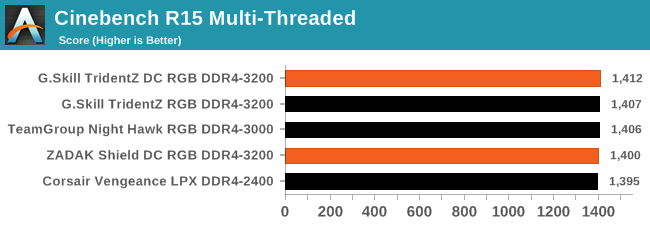
For power, we tested using Intel's Power Gadget tool, which has the hooks to test DDR4. The results show have two interesting scenarios. For power consumed per gigabyte, the new memory is fairly competitive:
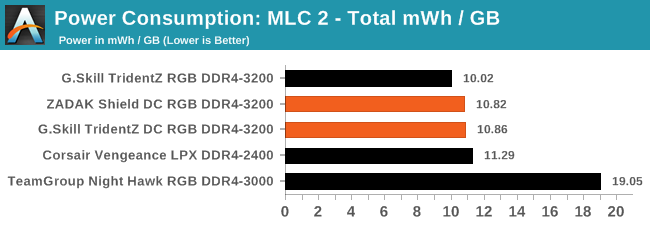
However, when we look at power per performance, in a benchmark where all the memory kits performed the same, then the value only comes from having the larger memory:
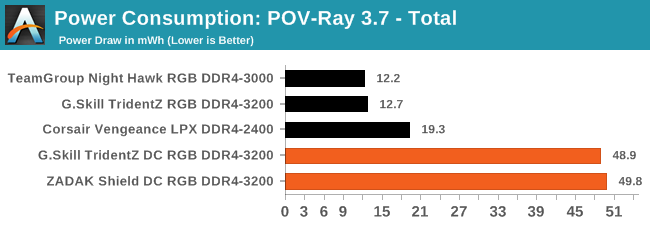
Compatibility
As mentioned, only three ASUS motherboards currently support this new double height DDR4 memory. It means these modules are going after a small market, or it will be up to system integrators to get the best deals for end-users when combining the right motherboard with the right memory. ASUS is keeping the details of how they enabled the new memory under wraps for now, likely seeing it as a competitive advantage in the aggressive motherboard market.
In the ASUS BIOSes, there's nothing much that gives them away, except that the BIOS shows that four memory slots are populated, despite the motherboard only having two available, confirming that each of these 32 GB memory modules are seen internally as 2x16GB modules.
Double Capacity, Double The Price
On the pricing front, this is down to the memory companies. G.Skill doesn't typically give official pricing for any of its kits, and the company states they like to be competitive per region on a weekly basis, which means they don't give 'global MSRPs' as they can change. The company did state however that the 2x32GB kits would be priced similar to its 4x16 GB kits. If this is right, the price for the G.Skill DC kits is expected to start from around $650 based on a 64 GB DDR4-3000 kit and closer to $1000 for DDR4-3200.
ZADAK unveiled its full MSRP pricing list to us. The baseline DDR4-2666 CL16 kit starts at $799, and the highest end DDR4-3600 kit finishes $1299.
Obviously, the benefits of the double height memory are focused on one key direction only: the need to have a total of 64 GB of memory in a particular form factor. Out of the three motherboards where this memory is actually qualified, only the Z390-I Gaming is a small form factor motherboard, so for users looking to optimize an SFF system, this would be the one to get. Larger systems rarely have this two memory slot limitation, and so the options for this memory are a lot larger, unless the user absolutely needs to use the Gene or the Apex motherboards from ASUS.


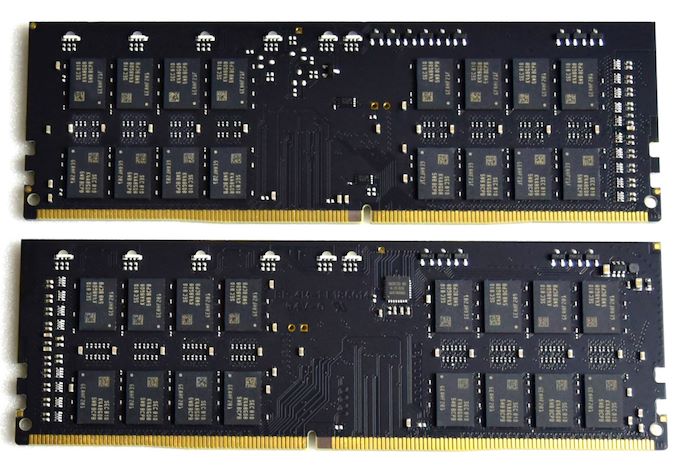
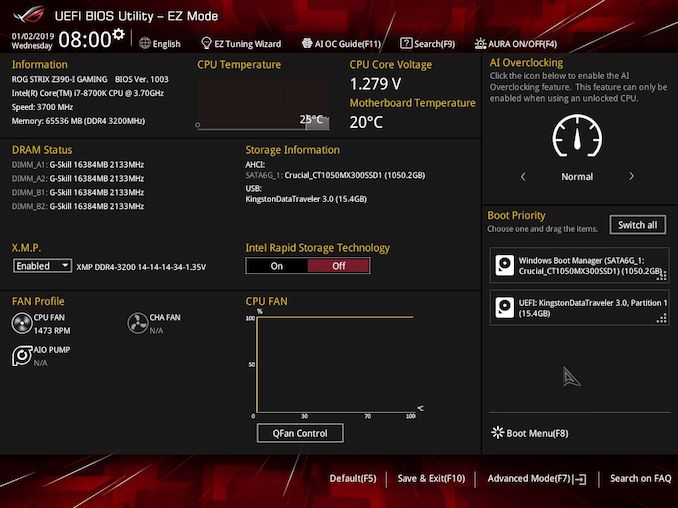
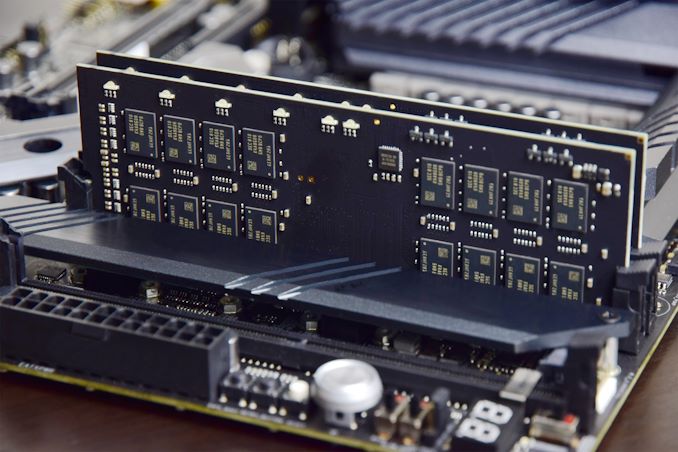








50 Comments
View All Comments
prateekprakash - Thursday, January 24, 2019 - link
Could you please mention the names of the motherboards which did not post with these memories?Also could you please try these with Intel 6xxx/ 7xxx series CPUs with 2xx chipsets ( z270, b250).
mito0815 - Thursday, January 24, 2019 - link
Any thoughts on how scalable this apporach is? I mean...the obvious issues (heatsink fan clearance being one of them) aside, 4-row-high-DIMMs would look absolutely hilarious. I'd buy them. Just for the joke.KarlKastor - Thursday, January 24, 2019 - link
I don't get why there is a need for double height.There are lots of DIMMs in the market, that have 18 ICs per side on a regular DIMM.
I think it's just marketing, to show visually they have something new. The Cooler occupies the space anyway. But don't get, why every Tech-website mention it's neccessary.
Targon - Thursday, January 24, 2019 - link
I suspect it is all about the memory density. So, rather than trying to get 7nm fab process RAM, these companies are using less expensive chips and just increasing the size of the board to compensate, plus the need to connect the RAM chips on the DIMM. What sort of timings are on these things, 2T, 3T, or 4T for the command rate? How about the latency ratings?KarlKastor - Friday, January 25, 2019 - link
Mh? I talk not about the number of DRAM Dies. I speak just about the size of the PCB. What has lithographie to do with PCB size?Here u have 16 packages per side. There are a lot of normal sized DIMMs outside with that amount of packages.
Danvelopment - Friday, January 25, 2019 - link
What are the use cases? I would have thought that, by the time you need those sort of capacities, you would be better served by a quad channel Xeon.NoSoMo - Friday, January 25, 2019 - link
Interesting -- now if they could just pair them with some 3D nand and allow hybrid RAM / storage like intel wants to do with optane. Perhaps it'd come in a variant that sees 16GB PC 3000 and a slot similar to M.2 with capacities that mirror that of NVMEs thus moving storage over to the RAM bus and freeing up the PCI bus. The modules would be L shaped so that the storage addition completes the form factor thus allowing it to retain the same profile as these taller units, vs having a module hanging off the side.13Gigatons - Wednesday, January 30, 2019 - link
Maybe they could focus on lowering the price????Other then that what is the case use?
DPete27 - Tuesday, February 12, 2019 - link
You can fit 2 SODIMMs using a single locking mechanism on each end within the limits of a mITX board. Surely that would be much easier and more universal.[img]https://lh3.googleusercontent.com/-L0fCpsbFSWA/We5...[/img]
ExclamationMediaLLC - Wednesday, July 10, 2019 - link
Hi Ian and Gavin! Very helpful article! I’m building a SFF workstation using these modules. I want to remove the heat spreaders but I’m afraid of damaging the DIMMs. I see you guys managed it. How risky is it? Is there anything special I should know about removing the RGB lighting strips? (Yes, everyone, I know it will void the warranty)